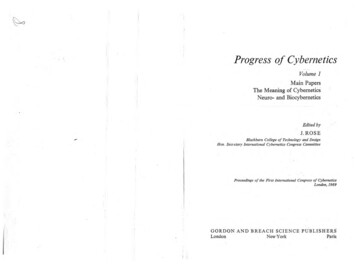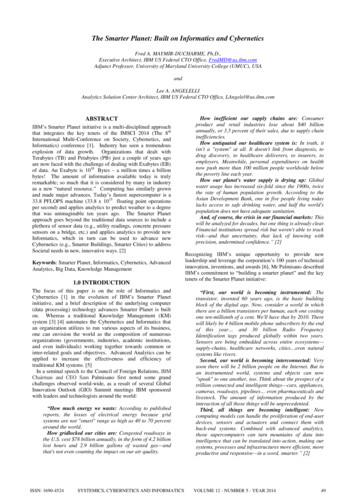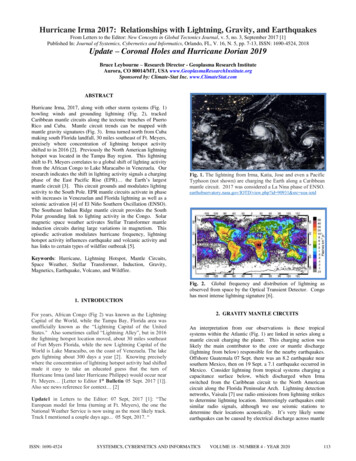
Transcription
\f . ,Progress of CyberneticsVolume 1I, IMain PapersThe Meaning of CyberneticsNeuro- and Biocybernetics,I .Edited byJ.ROSEBlackburn College of Technology and DesignHon. Secretary International Cybernetics Congress CommitteeProceedings of the First-International Congress of CyberneticsLondon, 1969'1.t, :,.,GORDON AND BREACH SCIENCE PUBLISHERSLondonPari New'Y ork
PrefaceCopyright 1970 byGordon and Breach, Science Publishers Ltd.12 Bloomsbury WayLondon W. C. 1Editorial office for the United States of AmericaGordon and Breach, SCience publishers, Inc.150 Fifth AvenueNewYork,N.Y.10011Editorial office for FranceGordon & Breach7-9 rue Emile DuboisParis 14eAn International Congress of Cybernetics was held In London in September,1969 the date ooinciding with the twenty-first formal birthday of the newinterdisciplinary science of cybernetics. This event was held under the aegisof an International Committee (LC.C.C.) composed of eminent academicsand cyberneticians from eighteen countries, and was supported by manyinternational bodies concerned with management, labour, cybernetics, thesciences and technologies, including U.N.E.S.C.O., LL.O. , etc. The aims ofthe congress, which marked a milestone in. the history of cybemetics' aI1.dmay well become the basis of a world organization, were as follows:(1)To establIsh cybernetics as an interdisciplinary science on solid foundations without the spurious accretions of the last two decades.(2) To exchange up-to-date information and meet as an internationalacademic .community.(3) To develop more efficient liaison between various scientists on an international scale.In accordance with the above the congress has decided to explore the possibility of establishing a World Organization of Cybernetics, under the aegisof an international agency, and a Cybernetic Foundation; the latter tofinance research, publications, establishment of institutions, etc.*The proceedings of the copgress are grouped in eight parts, viz. the mainpapers, followed by seven sections dealing with various aspects of cybernetics; authors from eighteen countries are represented. The main sectioncomprises eight papers contributed by the most eminent cyberneticians ofour times, the subjects treated covering the whole range of the science.Section I is concerned with the philosophy and meaning of cybernetics,Library of Congress catalog card number 73-111944. ISBNOfP7143109. All rightsreserved. No part of this book may be reproduced or utilized in any form or byany means, electronic or mechanical, including photocopy n , r cord g, or byany information storage and retrieval system, without permlsslOn III wntmg fromthe publishers. Printed in east Germany. Note added in proof As a result of a .world-wide enquiry, a World Organisationof General Systems and Cybernetics has been established. The Chairman of Councilis Professor W. Ross Ashby (U.S.A.), the VicejChairman is Professor Stafford Beer(U.K.), and the Director-General is Dr. J. Rose (U.K.).v
Main papers14are not accessible to the human brains. From there, if their conclusionsprove to be accessible to our powers of comprehension, they would perhapsbring back to us answers to the cumulative and seemingly insoluble problems of modern science.References1. M.Minsky, Proc.l.R.E. (lnsf. Radio Engrs.) ,CHAPTER M-2The meaning of cybernetics in thebehavioural sciences (The cybernetics ofbehaviour and cognition; extendingthe meaning of "goal"),,49, No.1 (1961).GORDON PASKSystem Research Ltd. and Institute of Cybernetics, Brunel University, U.K.!.(SummaryThe paper discusses the impact of cybernetic ideas upon behavioural andcognitive studies in general but the main thesis is developed in the contextof human psychology. An effort is 'm ade to trace the i uence of cyberneticsupon the development of psychological theor'les, eXperimental techniquesand methods for modelling mental and behavioural activity. Particularemphasis is placed upon the key concept of a "goal direded" system. It isargued that this concept becomes differentiated to yield t o specialisedforms of system, namely "taciturn systems" and "language orientedsystems"; of these, the latter are peculiarly important in connection withstudies of i11an or attempts to control, teach, or otherwise influence humanbeings. As it stands, the flOtion of "goal directed" system is unable to 'adumbrate the phenomena of evol1,ltionarydevelopment (as in open endedconcept learning) and conscious' experience, Problems entailing both typesof phenomena are ubiquitous in the human domain and the paper considersseveral ways in which the connotation of goal directed ness can be enlargedsufficiently to render it useful in these areas.15
16Main papersINTRODUCTIONFor many years, there has been a fruitful interplay between the interdisplinary pursuit of cybernetic ideas (bearing this label or not) and the specialdepartments of the life sciences. Since the early 30s, for example, anthropologists have .recognised that societal 40meostasis. depen s upon symbolicregulatory programmes manifest as rituals,. conventions, and traditions.Likewise, social changeis commonly understood in terms of the competitiveor. co-operative interaction between subsystems cl:).aracterised by these symbolic structures. '" Siinilar comments appiy at the l vel of animal populations,where the maintenance -of density, dispersion and interspecific mutualismdepend upon comparable processes (see, for example, Wynne Edwards 4 ).The whole of ethology is, by definition, the study of behaviours mediatingcontrol and communication; hence, cybernetics is an essential part of thisscience. t. Moving, in one direction the rea of cybernetic influence extendsinto studies of linguistics and kinship structures. '" In another direction, itinfiltrates biology (see, for example, Y 0ung 6 ), embryology (see Waddington 7), genetics, and developmental studies (for instance, Bomiet8).The crucial notion is that of a purposive or goal directed system. As theexamples suggest, this concept has served very well to ncrease our understanding of natural processes. But the concept, as it stands, is not entirelysatisfactory. The phenomena of evolution and of conscious experience areubiquitous in all biological, social, or Qehavioural systems. It is far fromclear that these phenomena can be explained (or even predicted and manipulated) within the existing cybernetic framework. A fundamental reapprai'- sal of the concept "goal" is probably necessary.Uneasiness over the adequacy of the existing framework has been expressed in various quarters; notably at the series of Wenner GFen symposiaon conscious purpose and human adaptation, convened by Gregory Bate;.son. This is not just an academic matter. In order to control the social andecological systems which nowadays shoVv\ signs of instability or even destructive and autocatalytic degeneration, it 4ges seem necessary to take the consciousness, self description and evaluation of these systems fully into account. Much the same theme will be qieveloped by Stafford Beer in the* The pioneering work is due to Bateson1 . R cent developments along similar lines aredocumented in Rappaport2 or Schwartz3 't -This is especially obvious in the works of Lorenz, Tinbergen, and -Mittelstadt.-'" A representative selection -of papers is cont;lined in Garvin3 M eaning of cybernetics in the behavioural sciences17context of government and management. Hence, the present paper willexamine the theoretical issues rather than dwelling upon their practicalconsequences.Berore embarking on this task, I must emphasize that these commentsrefer to behavioural and cognitive cybernetics. They are made from theviewpoint of some one concerned with natural systems and in no way contradict Prof. Boulanger's contention that issues of consciousness, etc., areoften irrelevant. In the previous paper Boulanger adopted the attitude of anengineer who is anxious to make purposive or intelligent artifacts. Fromthat point of view, of course, he is absolutely right. Wearing my engineeringhat, I entirely agree with him.CYBERNETICS IN RELATION TO HUMAN PSYCHOLOGYTo be specific, I shall trace the influence of cybernetic ideas upon a singlediscipline (human psychology). Here, as in the general domain, the :! eyconcept is "goal directed system" and it can be usefully refined in severalways. Once again, however, the concept of "goal" must be broadened inorder to deal with outstanding issues of consciousness, conceptual development and the like, which a comprehensive psychology cannot afford toneglect. After showing that the requirement for a more liberal interpretationof goal directedness arises quite naturally from the application of the con cept as it stands, I shall suggest several ways in Which the connotation of"goal" can be usefully extended.HistoryAt the moment when the word "cybernetics" first made its appearance,there existed two classes of psychological theory, each Qarryingits ownexperimental trappings , On the one hand, there was behaviouri'sm: either abrash, almost Watsonian, behaviourism or a: mellowed "functionalism donewith abehaviouristic bias" (chiefly represented in this country by the Cambridge School of Applied Psychology). On the other hand, there existed asort of mentalism, born of the Gestalt psychologies amongst others, whichwas pursued in a thoroughly eclectic spirit, for example, by Bartlett.Wiener's book 9 became widely known in.the early fifties . It gave a nameto an ongoing way of thinking and added mathematical stamina to abodyof embryonic concepts. Of course, Wiener had spoken as a pioneer before2 Rose, CyberneticsI
18Main papershe published. But his greatest innovation 'Yas philosophical and mathematical. The psychologists had been whittling: away at broader Cybernetic notions for some years. Amongst them were McCulloch 10 and Pitts in theU.S.A. and Ashby ll,12, at that time in Gteat Britain, who laid the foundations of that peculiarly cybernetic edifice; "the brain as a communicationand control system". Working at the behavioural level, Craik 13 saw theregulatory character of'human performance with enormo).1s clarity. Finally,there was a group of psychological information theorists, centred aboutHick l 4, and quite closely allied in their way of thinking. to physicalinformation theorists like Cherry i5 and Gabor (at Imperial College), Mackayand Shannon.Thereafter, cybernetic ideas became increasingly popular. Their proliferation can be followed both in the psychological literature and in therelevant sections of various interdisciplina·r forums (the Macy FoundationSymposia; the London Information Theory Symposia; the Congresses ofthe International Association of Cybernetics ; the Conferences on selforganizing systems,sponsored by ONR ; the Bionics Symposia, etc.). But,at the time in question (the early 50s), these concepts made a clear philosophical impression.Philosophical ImpactThe impact of cybernetics upon human 'psychology was any faceted.1) Cybernetics drew attention to the form and dynamics, i.e. the organi zation of systems, which is often of greater relevance than their physicalparticulars. Usefully, but more superficially, it mustered a number of mathematical techniques for talking about org nisation.2) By establishing the basic concepts of feedback and stability, cyberneticthinking resolved those teleological dilemmas that had lingered on since thevitalist-mechanist controversy of the early years of this century and gavesubstance to the already ubiquitous noti n of "goal directedness".(3) Within the cybernetic framework, the constituents of organization,namely information and control, acquired a status just as respectable as thatalre.ady accredited to "matter" ·or "energy".,(4) Conversely, it became evident that no system is ompletely specifiedby its physical description alone. The system's informational content and itscontrol structure must also be described (for example, the system "gene" isnot completely specified by talking about DNA molecules; in addition, a" !Meaning of cybernetics in the behavioural sciences19gene entails the information encoded in the molecular configuration and theprotein synthesising control loops in the context of which a gene is an hereditary unit). *(5) As a result, the Cartesian Dualism, of which the distinction betweenbehaviourism and mentalism is redolent, was replaced by a Systemic Monisim.Systemic MonisimThe crux of systemic monisim is contained in the assertion that any systemis a goal directed system which can be analysed into or (in context) synthesised from a collection of goal directed SUbsystems, The organisation of aI nstruc tjon to aim for nex t goalor general imperative (Oi f,ferencesignal zero or limits on effo r thave elapsed)Anticipated stateor description of- goa! G.' fiInstruCtion toinitiate contro!-or problem solving--.j'-- -JDifferencesigna!(non- erb)Description ofpresent stateFIGURE 1 The basic goal directed system: a TOTE unit (modified)goal directed subsystem, the basic building blOCk, is the familiar processdepicted in Figure 1. Notice that the organization is isomorphic with anyof the following entities.(1) A TOTE (or TEST, OPERATE, TEST, EXIT) unit, in the sense ofMiller, Galanter, and Pribram 16 .* In view of later (essentially cybernetic) work in olecular biology, there is currentlysome doubt about hereditary units; the DNA config(;rration probably does not uniquelyspecify the organisation. However, the meaning of the example is clear enough.
M eaning of cybernetics in the behavioural sciencesMain papers20Hence, the reductionist explanations of human behaviour and mentationin a cybernetic discussion are quite distinct from those (to mymmdfa la lOus) mechanistic explanations in which man is reduced to a bagof aSSOCIatIOns and responses. To parody the position of naIve behaviourism,man is conceived as something that reacts to stimuli. In contrast, the cybernetic theories of psychology envisage man as someone who interprets, intends,and anticipates. To put it differently, a human being does not so much respontl ' to stimuli as interpret certain states of his environment as posingproblems which he makes an attempt to solve. Clearly, this point of viewbridges the gap between behaviourism and cognitive psychology. A humanbeing has the qualities ordinarily associated with mental activity; nevertheless, the human system is, in principle, reducible to elementary subsystemswhich have the same quality in a primitive form. Whether or not such areductive explanation is genera:Ily possible is undecided at the moment ; atany rate" useful explanations can be offered for certain aspects of humanactivity. Whether the goal directed unit is a rich enough construct to adum jbrate "interpretation, intention, and anticipation" is a question to be takenup in a moment. Some disquiet on this score has been voiced already.(2)-The interpretation and execution of an IF, THEN, ELSE progra,mmeth t featur segment.(3) A properly interpreted control system.(4) A problem solver.(5) A game player (the equivalence of (3), (4), and ,(5) was mooted by1Ashby and has recently been developed.:by Banerji) 7. -Instrudianto aim for ne'xt goalInstruc tionto initiatecontrol orproblem solvingFIGURE 2 A typiCal decomposition of goal G: a TOTE hierarchy(modified)(6) The execution of a state achievement command in the sense ofRescher1B (7) An elementary concept (regarded as a procedure for knowing or re-Cogency of the Cybernetic Approach19jcognizing or doing) (8) Either the process of "abstraction" or of "completing an analogy" 20.There are several ways of conjoining goal directed. systems so that theentire system is goal directed (or, conversely, of disse'cting a goal directedsystem into elementary units). One of them is shown in Figure 2. Here theentire syst(m has a goal G and subgoals G 1 and G 2 . In order to attain G,the uppermost unit calls for the exec'\ltion of,a G1 subroutine and a G2 sub routine, such a predictive sequence being a plan. Other types of compositionand decomposition are discussed in a recent paper21.Holism and AtomismSince it holds that composition and d composition are universally possible,systemic monisim is a reducticinist philosophy. But, in general, it is holisticrather than atomistic since, apart from a few trivial cases, the whole goaldirected system is more than the sum pf its goal dire6ted parts. Further, ina sense that will be clear from the slightly unusual hbelling of Figure 1, ach subsystem can be said to interpret, to intend, and to anticipate or expect.21iI" , r:Since it resolves the arid conflict between behaviourism and mentalism thecybernetic approach effects a salutory unification of the psychological field.Several :heories of learning and cognition "have been built up in overtlycybernetIc terms; for example, in the U.S.A., the theories of Miller, Gallanter, and Pribram 16 , McCulloch1o, and von Foerster 22 ( r von Foersteret aI.23); in the U.S.S.R., the theories of An.-ohkin, Amosov 24, Glushkov 25,and Napalkov and in Great Britain, my own theory26,27. To these shouldbe added all theories involving cognitive and artificial intelligence models 'which are built up from elementary constituents with the status of information structures, for example, the models of Minsky28, Reitman 29 Huntet ape , Fogel et aPt, George 32 , Taylor 33, Uttley34, and Young 6 .' Manyt?eori:s are primarily cybernetic in calibre; notably, Festinger's35 "cognitIve dIssonance", Kelly's "personal constructs" and Laing's theory (seeLaing et al. 37) of interpersonal interaction.Apart from this, the literature abounds with papers that are couched inbehavioural terms but which are really talking about cybernetic constructs.Nowadays, when mental mechanisms are called "mediating processes" or
22Main papers(at a different level of discourse) are signified by "intervening variables" theauthor is nearly always referring to goal directed systems, programmes, andthe like. The nomenclature of S.R. theory is cumbersome in this context;during a transition phase it is used by way of an apologia to classical behaviourism but is gradually being replaced by direct refe,rence to the cybernetic entities .t\longside this theoretical development a number of cybernetic methodologies have come into prominence. The most general o these, informationtheory and control theory, have already been mentioned. More specifically,the idea of a basic experimental situation is undergoing rapid change. Theparadigm used to be a stimulus and response situation; now it is beingequated with a game or a conversation between the su ject and the experimeter (or his equipment, in Some cases).:The consequence of this change in attitude extend far beyond the laboratory. They are particularly dramatic in bonnection with teaching, training,and computer assisted instruction, whery sensible developments almost certainly rest upon the recognition that a tiutorial conversation is the minimal,non trivial, transaction with a human being (here, incidentally, I mean conversation in the full-blooded logical sense; hence, "conversational interaction" with a simple computer terminal is generally insufficiently rich toqualify). These matters have been discus ed extensively in other publicationsand I shan not dwell upon them 38 - 45. ' :Cybernetic theories and methods can be justified on p ychological grounds;for example, the acquisition of either ki11s or concepts is most naturallydescribed in cybernetic terms, as are the phenomena of selective attention.Empirically, cybernetic theories "work" quite well. However, the experiments of Dr. Grey Walter (which he will outline later this morning) lend agreat deal of more specific support to the cybernetic contention. This work*has uncovered the physiologIcal foundations for the 'goal directedness ofman. Broadly, a complex of mechanisms involving the frontal cortex andcertain lower regions such as the retiqularformation, focus the attentionupon relevant evidence and set up an anticipation or expectation with respectto its correlates and to properly equilibrating actions. In particular, theactivity of this "expectancy" system depends upon either (1) a goal settinginstruction (do so and so when something happens) O,! (2) an internal goal,; This is a refinement and extension of other work in the fiel11. For particular theoriesin this matter, see Grey Walter 46 and Kilmer etal. 47 For the physiological backgroundsee Lynn 48 .iMeaning of cybernetics in the behavioural sciences23orienting state. Generally speaking, a human being habituates against stimuli that are irrelevant to goals. Those which are relevant become significant, i.e. they pose problems or provide evidence (they do not simply "elicitresponses").It is right and r asonable to be impressed when physiology and psychologyare happy bedfellows. In view ot: thIS work, there can be no serious doubtthat human beings can be fruitfully represented as cybernetic systems.DETAILED EXAMINATION OF CYBERNETIC THEORIESEarlier in the paper I questioned the theoretical adequacy of the goal directedsystem as currently conceived and suggested that it is necessary to broadenour view of what such a system is. This calls for a more thoroughgoing 'appraisal of "goals" and of "cybernetic theories" in general.Theory Building"Any theory starts off with an observer or experimenter. He has in mind acollection of abstract models with predictive capabilities. Using various criteria of relevance, he selects one of them. In order to actually make predictions, this model must be interpreted and identified with a real assembly toform a theory. The interpretation may be prescriptive and predictive, aswhen the model is used like a blueprint for ,designi'ng a machine and predicting its states. On the other hand, it may be d,escriptive and predictive asiUs when the model is used to explain and predi t the b haviourof a givenorganism.Now, in order to establish the identification and to form a predictivetheory (indeed, in order to select one model from the set of possibilities), theobserver needs to know the purpose for or the purpose of the system withwhich the model is identified. Lacking such a purpose, the observer wouldbe at a loss to know what constitutes a sensible interpretation of the modelor what properties of the world are relevant. In essence, of course, the purpose for or the purpose of the system is invented by the observer himselfand it is stated in an observer's metalanguage for talking about the system.Thus, in the prescriptive mode, it is clear that people do not build purposeless machines. Equally, in the descriptive mode,an observer gets nowhereunless he has a systemic purpose in mind;! for example, no headway wasma4e with the eXiplanation of amphibian vision until Lettvin, Matturana,
24Main papersMcCulloch and Pitts* conceived the frog visual system as a machine for(with the purpose of) catching insects and avoiding predators. At that point,it became evident that the visual system consists in a set of attribute filters,evaluating properties relevant to this purpose.In contrast, some systems have a purposebuiIt into them; a "purpose in",i.e. a goal. Depending upon the type of observation we have in mind thismay mean either (1) the models with which:these systems are identified necessarily contain the mechanism of a goal directed system or (2) the system can stategoals to the observer and accept some goals from him (or hoth). The principal cybernetic hypothesis can now be phrased as follows . .,Any system witha purpose for it (any system for which a cybernetic theory can be constructed)also has a purpose in it, i.e. a goal; all systems are goal directed systems.Notice, in passing, the consequences of this definition. A pybernetic theoryof adding machines is not just a theory of mechanical devices which haveno goal. It refers directly to the process of addition and indirectly to the userof the adding machine, i.e. the· mechanica] device is necessarily embeddedin the context which makes it meaningful. !Structuraland Organizational Models.iIt follows from these comments that the truth of the cybJrnetic hypothesiscannot be decided (in respect to a particular system) at th level of the mostfundamental and the simplest type of model: Ashby's "black box". However long a system identified with such a model is observed and howevermany experiments are carried out by varying the "black box" input, it willonly be possible to say that the system behaves as though it is (or is not) agoal directed system. The whole concept of goal directedr;tess depends uponthe interpretation of a structural or organizational model for the system;something having enough detail to delineate the goal seeking process.tHence, in talking about goals, there i a tacit commitment to structuraland organizational models containing a modicum of detail. At this level of* "What the frog's eye tells the frog's brain" in Embodiments of Mind 10 t This is quite clear in Ashby's work, of coursf::. For example, in Design for a Brainllthe concept of essential variables with limits upoJf their permissible values is employed toset up a goal directed system. The matter is generalized in Ashby's later work (see e.g.Ashby48). The present point is that structural ·notions, such as " ssential variables" donot stem directly from the observation of a black box system. They are imported as aresult of independent observations, e.g. data bearing on the natur of the animal.Meaning of cybernetics in the behavioural sciences25discussion, still with human psychology in mind, it becomes useful to introduce a distinction between two types of goal directed system, namely taciturn and language oriented systems. * The former are systems in (roughly)the sense of general systems theory. The latter are. based upon the concept?f an object la guage (defined or described in the observer's metalanguage)11l terms of WhICh the system is able to accept goal statements (by programming or reprogramming) and to describe its current goals. The distinction"taciturn/language oriented" fundamentally entails the observer' we meanto be strict "observed as taciturn/observed as language oriented". Never theless, these are features of the system, per se, which dispose us towardsone mode of observation or the other . .Taciturn and Language Oriented SystemsTaciturn systems are those for which the observer asserts or discovers thegoal (purpose in), which is thereafter equated with the purpose for the system in question. In contrast, language oriented systems can be asked or ·instructed- to adopt goals by anyone who knows the object language andthey may state and describe their own goals, using the same medium; in avery real sense these are "general purpose" systems. Ostensively, the distinction is determined by the following features.(1) A special purpose, goal directed, computing machine (such as an autopilot) is a taciturn system. In contrast, a geneml purpo,se computer togetherwith the compilers, interpreters, etc., required for processing statements ina programming language is a language oriented system. The programminglanguage is the object language upon which the systc;:m isba,sed.Although this example is instructive, th peculiar character of generalpW'pose computers must be kept firmly in mind throughout the discussion.In the case of a computer, an observer knows the programming languageeither because he has designed the machine or because he has a program-* The basic distinction between taciturn and language oriented systems can be madein several ways of which this one is the most convenient for the present purpose. For example, Gregory50 makes a similar spirited distinction between systems with a deductivecapability (roughly, language oriented) and those without ·such a capability (roughly taciturn). Although Gregory's differentiation is elegant, and just as proper as my own, it doesnot fit the present framework quite so well. The caveat, roughly, must be taken seriously.As Figure 1 is labelled, any system with a goal (a purpose in) has a claim to deductivepower.
Meaning of cybernetics in the behavioural sciencesMain papers26sibility as well, which is not open for the taciturn system. Clearly, the language oriented system can define a set of alternatives in terms of its ownobject language*; conversely, it can be given a set of alternatives. Withrespect to these it can express subjective or systemic uncertainty.,When the model for the language oriented system has been used pi'escriptively, as in writing an artificial intelligence programme, the observe.!' cangive an operational interpretatiml of subjective uncertainty and of the corresponding subjective information measure; for example, the degree of uncertainty with reference to problem P is the amount of computation requiredto solve P or the amount of computation which the system estimates will beneeded at the moment it makes an utterance. When the model is used descriptively, an operational interpretation is not generally available and theasserted subjective uncertainties both may be and can be regarded as primitive measures. For instance, if man is a language oriented system, it is legitimate to take confidence estimates, obtained by the vei'idicial scoring technique of Shuford and his colleaguest, as primitive indices of the systemstate. Objective indices, which may, of course, be closely correlated ,witllthem are, according to this point of view, indirect state descriptors .(5) The model for a taciturn system is identified with reality (for example,in the context of an experiment) by setting up a material analogy'*' betweenming manual written by someone who did so. In the case of a psychologicalsystem, an observer knows the programn:iing language either because hespeaks and understands it, or because of arguments involving inferences ofsimilarity between the system and himself.,(2) A taciturn system can neithe
Paris 14e Library of Congress catalog card number 73-111944. ISBNOfP7143109. All rights . INTRODUCTION For many years, there has been a fruitful interplay between the interdispli . The impact of cybernetics upon human 'psychology was any faceted. 1)










